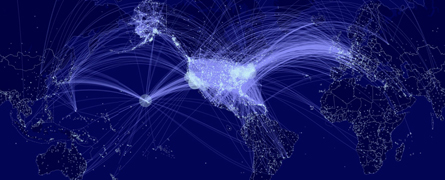Airports that speed germs’ spread
Scientists identify which U.S airports are able to spread disease most effectively

Imagine if you were an infectious disease, like the flu or chicken pox. To keep yourself alive, you’d want to infect as many people in as many places as possible. And inside those people, you’d want to grow, divide and multiply. To accomplish all of this, you would need a plan.
Now, you’ve got one: Start at an airport in New York City or Los Angeles.
In a July scientific journal, a team of researchers reports that busy, well-connected hubs in these two cities are the best U.S. airports for germs to spread far and wide.
The researchers used computer programs to simulate an epidemic, or an outbreak of disease that affects more people than expected. (This year, the state of Washington is experiencing an epidemic of pertussis, or whooping cough, a highly contagious disease that causes severe coughing. Pertussis is best prevented through vaccination.) Public health experts use simulations to try to figure out how to minimize the spread of disease. This recent simulation focuses on the early days of an epidemic. It helps point to where officials might want to first send resources like vaccinations.
Ruben Juanes, an engineer at the Massachusetts Institute of Technology in Cambridge, worked on the new study. He and his colleagues used the simulation to produce a list of 40 U.S. airports that would be the best at spreading disease. They collected information on all flights originating or landing in the country between January 2007 and July 2010. The team also collected data on how long passengers had to wait at airports between flights.
New York and Los Angeles are big cities. So it’s probably not surprising that their international airports were best at spreading a disease simulated to originate in those cities.
Honolulu, coming in third place, was a surprise. That city’s airport is relatively small, only the 25th largest in the nation in terms of number of passengers. But Juanes and his colleagues found that the number of passengers passing through may be less important than the distances spanned by an airport’s connections. As in those top-ranking airports in New York City and Los Angeles, airplanes at Honolulu International fly long distances in many directions to large U.S. and foreign airports that have lots of other flights going to other large cities.
That connectedness appears to be key — even more important than the number of passengers passing through the terminals each day. So if you’re a germ, Juanes has a travel tip for you: Look for a busy airport connected to many other busy airports.
“That’s what’s really essential,” he told Science News.
Power Words
epidemic A widespread occurrence of an infectious disease in a community at a particular time.
vaccination A treatment given to produce immunity, or resistance, to a disease.
simulation An imitation of a real event, often carried out mathematically with the help of a computer.
infectious Likely to be transmitted to people and other organisms through the environment.







